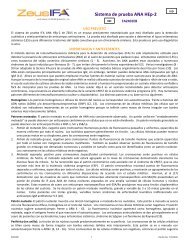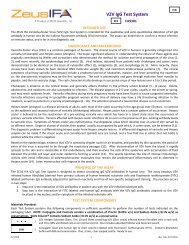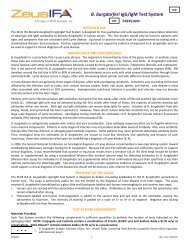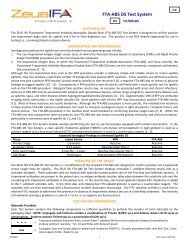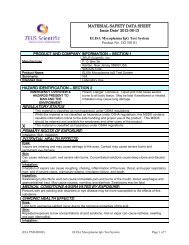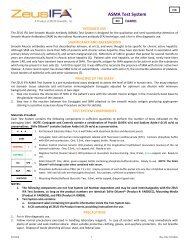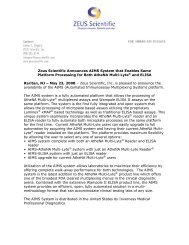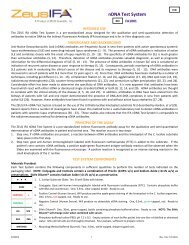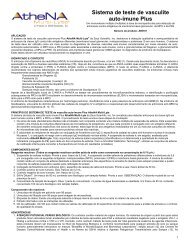AAS Mouse Kidney/Stomach/Liver Tissue Test ... - ZEUS Scientific
AAS Mouse Kidney/Stomach/Liver Tissue Test ... - ZEUS Scientific
AAS Mouse Kidney/Stomach/Liver Tissue Test ... - ZEUS Scientific
Create successful ePaper yourself
Turn your PDF publications into a flip-book with our unique Google optimized e-Paper software.
TM<strong>AAS</strong> <strong>Mouse</strong> <strong>Kidney</strong>/<strong>Stomach</strong>/<strong>Liver</strong> <strong>Tissue</strong> <strong>Test</strong> SystemREFFA3403IVDINTENDED USEThe <strong>ZEUS</strong> IFA Autoantibody Screen (<strong>AAS</strong>) <strong>Mouse</strong> <strong>Kidney</strong>/<strong>Stomach</strong>/<strong>Liver</strong> <strong>Tissue</strong> <strong>Test</strong> System is designed for the qualitative and semiquantitativedetection of antinuclear, mitochondrial, smooth muscle and parietal cell antibodies by the indirect fluorescent antibodyIFA technique. It aids in determining SLE and differentiating clinically similar connective tissue disorders, and is for In Vitrodiagnostic use.SIGNIFICANCE AND BACKGROUNDThe <strong>ZEUS</strong> IFA <strong>AAS</strong> <strong>Mouse</strong> <strong>Kidney</strong>/<strong>Stomach</strong>/<strong>Liver</strong> <strong>Tissue</strong> <strong>Test</strong> System combines the <strong>ZEUS</strong> IFA Mitochondrial Antibody <strong>Test</strong> System andthe <strong>ZEUS</strong> IFA Smooth Muscle Antibody <strong>Test</strong> Systems into a single system, which enables one to monitor four primary autoantibodiesin a single test. This <strong>Test</strong> System will simultaneously detect antinuclear, mitochondrial, smooth muscle, and parietal cell antibodies.The <strong>ZEUS</strong> IFA <strong>AAS</strong> <strong>Mouse</strong> <strong>Kidney</strong>/<strong>Stomach</strong>/<strong>Liver</strong> <strong>Tissue</strong> <strong>Test</strong> System is designed for use in conjunction with the <strong>ZEUS</strong> IFA ANA, MA,and SMA specific <strong>Test</strong> Systems.The IFA technique was adapted to antinuclear antibody testing by several investigators (1 - 2) following the basic methods originallydescribed by Coons (3). This method has been used extensively for detecting the presence of ANA in the sera of patients withsystemic lupus erythematosus (SLE), and other clinically similar connective tissue disorders (4 - 8). In addition, ANA may beassociated with numerous drug-induced lupus syndromes (9 - 10) which clinically mimic the spontaneous form of SLE. ANA areprimarily composed of IgG; however, IgA and IgM ANA may also be detected (11). It is now recognized that many sources of nuclearmaterial may be employed as a substrate for ANA testing. There are several different patterns of nuclear fluorescence (12 - 19).These various patterns and the basis for them are as follows:Homogeneous (Solid diffuse) - Diffuse staining of the entire nucleus due to antibodies reactive with DNA-Nucleoprotein-Histonecomplexes (14 - 15).Peripheral (Rim, Shaggy) - Staining of the nuclear membrane due primarily to antibodies directed against DNA (6, 13, 16, and 17).Speckled - Specks of staining dispersed throughout the nucleus due to antibodies directed against extractable nuclear antigens, RNP,or Sm (18, 19).Nucleolar - Staining of the nucleolar membranes due to antibodies reactive with RNA - nucleoprotein complexes (13). Although thelevel of ANA may not correlate with the clinical course of a particular autoimmune disease state (6), the various patterns of nuclearstaining may be associated with specific disease states (6, 17, and 21 - 24).Mitochondrial antibodies (MA) are found predominantly in patients (84% - 100%) with Primary Biliary Cirrhosis (PBC) and onlyoccasionally (10% or less) in patients with chronic active hepatitis, cryptogenic cirrhosis and other diseases (25, 26 - 29). For thisreason, tests for MA have been recommended as a substitute for surgical exploration to provide confirmatory evidence when thediagnosis of PBC is suggested by clinical and laboratory features or histological findings (30 - 32). This recommendation is furthersupported by the absence of MA in extrahepatic biliary obstruction (33). Although the exact etiology of PBC has not beendetermined, the association of PBC with certain tissue antibodies, particularly MA, is well established (29, 30 - 32). It has beensuggested (25) that PBC, chronic active hepatitis, and cryptogenic cirrhosis are various manifestations of a common autoimmuneprocess. This was based on the observation that similar autoantibodies may be detected in the serum of all three diseases (25, 35).Recent reports suggest that HBsAg may be the etiologic agent for PBC (34) and possibly other liver diseases (35).Smooth Muscle antibodies (SMA) were first described by Johnson, et al (36) and were thought to be specific for chronic activehepatitis. Although SMA are found in more than 50% of patients with chronic active hepatitis, they have also been found inassociation with PBC (37), asthma (38), and certain malignancies (39). SMA titers of 1:80 or greater that persist for several monthsto years are characteristically found in chronic active hepatitis (29). Patients with viral hepatitis on the other hand, rarely have titersabove 1:40, and only have transient trace amounts of SMA. The specific antigen for SMA appears to be actin or actin-like substanceswhich may be present in liver cells (40). Until this report (40), it was difficult to reconcile the presence of SMA with chronic activeliver disease. Another report has shown SMA to be an autoantibody reactive with actin (41), the contractile substance of platelets,brush borders of epithelial cells, and other substances (41).Parietal-Cell antibodies (PCA) are seen in 90% of pernicious anemia patients. The test is helpful in differentiating this anemia fromother macrocytic anemias. The parietal-cell antibody is seen in a large percentage of cases of atrophic gastritis and noted in asignificant percentage of patients with iron deficiency anemia, thyroid disease, idiopathic Addison’s disease, and juvenile diabetesmellitus (42). About one-third of the patients with thyroiditis or Graves’ disease have parietal-cell antibodies (42, 43). In normalsubjects, parietal-cell antibodies are rare under the age of 20 years. There is an increasing incidence with age in females and males,which reflects increased frequency of atrophic gastritis (43). Intrinsic factor antibodies are usually of the IgG class and are found in50 - 70% of patients with pernicious anemia (43). The intrinsic factor antibody is rarely seen in the absence of pernicious anemia.R2003EN 1 (Rev. Date 7/3/2013)
PRINCIPLE OF THE ASSAYThe <strong>ZEUS</strong> IFA <strong>AAS</strong> <strong>Mouse</strong> <strong>Kidney</strong>/<strong>Stomach</strong>/<strong>Liver</strong> <strong>Tissue</strong> <strong>Test</strong> System is a pre-standardized assay designed to screen patient sera forantinuclear, mitochondrial, smooth muscle and parietal-cell antibodies utilizing a single test procedure. The assay employs stomachkidney, and liver tissue substrate sections in each well of an eight-well Slide. Antibodies are then diluted using goat anti-humanimmunoglobulin Conjugate adjusted for optimum use dilution with minimum background staining. The reaction occurs in two steps:1. Step one involves the interaction of antibody in the patient’s sera with the antigen on the Slide. In a positive specimen,antibodies in the serum will bind to the tissue section and remain attached after rinsing.2. Step two is the reaction between the Conjugate and the antigen-antibody reaction that produces an apple-green staining in apositive assay (see Assay Procedure).The <strong>ZEUS</strong> IFA <strong>AAS</strong> <strong>Mouse</strong> <strong>Kidney</strong>/<strong>Stomach</strong>/<strong>Liver</strong> <strong>Tissue</strong> <strong>Test</strong> System should be used to screen patients suspected of having SLE orother connective tissue diseases, autoimmune liver disease, such as chronic active hepatitis, or primary biliary cirrhosis, patientswith pernicious anemia, and patients with symptoms consistent with possible autoimmune disease.ANA: In a positive assay, the antinuclear antibody in the patient’s sera interacts with the kidney, stomach, and liver nuclei. With theaddition of the FITC Conjugate, an apple-green staining will occur. Antinuclear antibodies will exhibit a homogeneous, rim, speckled,or nucleolar pattern.MA: In a positive assay, the mitochondrial antibody in the patients sera interacts with the mitochondrial antigens localized in thekidney proximal and more intensely, in distal tubular epithelium and gastric (stomach) parietal cells. Reactions with mitochondrialantigens in the liver cells will also be evident. With the addition of the FITC Conjugate, an apple-green staining will occur within theabove structures.SMA: In a positive assay, the smooth muscle antibody in the patient’s sera interacts with the smooth muscle antigen in themuscularis band basal to the glandular mucosa of the stomach and in the smooth muscle tissue in the blood vessel walls. With theaddition of the FITC Conjugate, a positive reaction is indicated by an apple-green staining within the muscularis band and bloodvessel walls.PCA: In a positive assay, the parietal-cell antibody in the patient’s sera interacts with the gastric (stomach) parietal cells and not withthe kidney proximal or distal tubular epithelium. With the addition of the FITC Conjugate, an apple-green staining will occur.TEST SYSTEM COMPONENTSMaterials Provided:Each <strong>Test</strong> System contains the following components in sufficient quantities to perform the number of tests indicated on thepackaging label. NOTE: Conjugate and Controls contain a combination of Proclin (0.05% v/v) and Sodium Azide (
2. <strong>Test</strong> System also contains:a. Component Label containing lot specific information inside the <strong>Test</strong> System box.b. A CD containing all <strong>ZEUS</strong> IFA Product Inserts, providing instructions for use.PRECAUTIONS1. For In Vitro diagnostic use.2. Follow normal precautions exercised in handling laboratory reagents. In case of contact with eyes, rinse immediately withplenty of water and seek medical advice. Wear suitable protective clothing, gloves, and eye/face protection. Do not breathevapor. Dispose of waste observing all local, state, and federal laws.3. The wells of the Slide do not contain viable organisms. However, consider the Slide potentially bio-hazardous materials andhandle accordingly.4. The Controls are potentially bio-hazardous materials. Source materials from which these products were derived were foundnegative for HIV-1 antigen, HBsAg and for antibodies against HCV and HIV by approved test methods. However, since no testmethod can offer complete assurance that infectious agents are absent, these products should be handled at the Bio-safetyLevel 2 as recommended for any potentially infectious human serum or blood specimen in the Centers for DiseaseControl/National Institutes of Health manual “Biosafety in Microbiological and Biomedical Laboratories”: current edition; andOSHA’s Standard for Bloodborne Pathogens (20).5. Adherence to the specified time and temperature of incubations is essential for accurate results. All reagents must be allowedto reach room temperature (20 - 25°C) before starting the assay. Return unused reagents to their original containersimmediately and follow storage requirements.6. Improper washing could cause false positive or false negative results. Be sure to minimize the amount of any residual PBS, byblotting, before adding Conjugate. Do not allow the wells to dry out between incubations.7. The SAVe Diluent ® , Conjugate, and Controls contain Sodium Azide at a concentration of
9. 1 Liter Graduated Cylinder.10. Laboratory timer to monitor incubation steps.11. Disposal basin and disinfectant (i.e.: 10% household bleach – 0.5% Sodium Hypochlorite).The following filter systems, or their equivalent, have been found to be satisfactory for routine use with transmitted or incident lightdarkfield assemblies:Transmitted LightLight Source: Mercury Vapor 200W or 50WExcitation Filter Barrier Filter Red Suppression FilterKP490 K510 or K530 BG38BG12 K510 or K530 BG38FITC K520 BG38Light Source: Tungsten – Halogen 100WKP490 K510 or K530 BG38Incident LightLight Source: Mercury Vapor 200, 100, 50 WExcitation Filter Dichroic Mirror Barrier Filter Red Suppression FilterKP500 TK510 K510 or K530 BG38FITC TK510 K530 BG38Light Source: Tungsten – Halogen 50 and 100 WKP500 TK510 K510 or K530 BG38FITC TK510 K530 BG38SPECIMEN COLLECTION1. <strong>ZEUS</strong> <strong>Scientific</strong> recommends that the user carry out specimen collection in accordance with CLSI document M29: Protection ofLaboratory Workers from Occupationally Acquired Infectious Diseases. No known test method can offer complete assurancethat human blood samples will not transmit infection. Therefore, all blood derivatives should be considered potentiallyinfectious.2. Only freshly drawn and properly refrigerated sera obtained by approved aseptic venipuncture procedures with this assay (44,45). No anticoagulants or preservatives should be added. Avoid using hemolyzed, lipemic, or bacterially contaminated sera.3. Store sample at room temperature for no longer than 8 hours. If testing is not performed within 8 hours, sera may be storedbetween 2 - 8°C, for no longer than 48 hours. If delay in testing is anticipated, store test sera at –20°C or lower. Avoid multiplefreeze/thaw cycles which may cause loss of antibody activity and give erroneous results.STORAGE CONDITIONSUnopened <strong>Test</strong> System.Mounting Media, Conjugate, SAVe Diluent ® , Slides, Positive and Negative Controls.Rehydrated PBS (Stable for 30 days).Phosphate-buffered-saline (PBS) Packets.ASSAY PROCEDURE1. Remove Slides from refrigerated storage and allow them to warm to room temperature (20 - 25°C). Tear open the protectiveenvelope and remove Slides. Do not apply pressure to flat sides of protective envelope.2. Identify each well with the appropriate patient sera and Controls. NOTE: The Controls are intended to be used undiluted.Prepare a 1:20 dilution (e.g.: 10µL of serum + 190µL of SAVe Diluent ® or PBS) of each patient serum. The SAVe Diluent ® willundergo a color change confirming that the specimen has been combined with the Diluent.Dilution Options:a. As an option, users may prepare initial sample dilutions using PBS, or Zorba-NS (Zorba-NS is available separately. OrderProduct Number FA025 – 2, 30mL bottles).b. Users may titrate the Positive Control to endpoint to serve as a semi-quantitative (1+ Minimally Reactive) Control. In suchcases, the Control should be diluted two-fold in SAVe Diluent ® or PBS. When evaluated by <strong>ZEUS</strong> <strong>Scientific</strong>, an endpointdilution is established and printed on the Positive Control vial (± one dilution). It should be noted that due to variationswithin the laboratory (equipment, etc.), each laboratory should establish its own expected end-point titer for each lot ofPositive Control.c. When titrating patient specimens, initial dilutions should be prepared in SAVe Diluent ® , PBS, or Zorba-NS and allsubsequent dilutions should be prepared in SAVe Diluent ® or PBS only. Titrations should not be prepared in Zorba-NS.3. With suitable dispenser (listed above), dispense 20µL of each Control and each diluted patient sera in the appropriate wells.R2003EN 4 (Rev. Date 7/3/2013)
4. Incubate Slides at room temperature (20 - 25°C) for 30 minutes.5. Gently rinse Slides with PBS. Do not direct a stream of PBS into the test wells.6. Wash Slides for two, 5 minute intervals, changing PBS between washes.7. Remove Slides from PBS one at a time. Invert Slide and key wells to holes in blotters provided. Blot Slide by wiping the reverseside with an absorbent wipe. CAUTION: Position the blotter and Slide on a hard, flat surface. Blotting on paper towels maydestroy the Slide matrix. Do not allow the Slides to dry during the test procedure.8. Add 20µL of Conjugate to each well.9. Repeat steps 4 through 7.10. Apply 3 - 5 drops of Mounting Media to each Slide (between the wells) and coverslip. Examine Slides immediately with anappropriate fluorescence microscope.NOTE: If delay in examining Slides is anticipated, seal coverslip with clear nail polish and store in refrigerator. It is recommendedthat Slides be examined on the same day as testing.QUALITY CONTROL1. Every time the assay is run, the Positive Controls, Negative Control and a Buffer Control must be included.2. It is recommended that one read the Positive and Negative Controls before evaluating test results. This will assist in establishingthe references required to interpret the test sample. If Controls do not appear as described below, results are invalid.a. Antinuclear Antibody: Homogeneous Positive Control is characterized by diffuse staining of the entire nucleus in thekidney, stomach, or liver sections. The Negative Control is characterized by the absence of specific fluorescence and a redbackground staining of all the cells due to Evans Blue counterstain.b. Mitochondrial Antibody: The Positive Control is characterized by apple-green staining in the proximal and distal tubularepithelium, gastric (stomach) parietal cells or liver cells, with a staining intensity of 2+ to 4+. The Negative Control ischaracterized by the absence of fluorescent staining of the kidney cells.c. Smoothmuscle Antibody: The Positive Control is characterized by apple-green fluorescent staining on the muscularis bandof the stomach substrate. The Negative Control is characterized by the absence of fluorescent staining on the muscularis ofthe stomach muscle.d. Parietal Cell Antibody: The Positive Control is characterized by a granular apple-green staining of the stomach parietal cellsin columns that surround the smooth stomach muscularis band. The Negative Control is characterized by the absence offluorescent staining in any of the stomach cells.3. Additional Controls may be tested according to guidelines or requirements of local, state, and/or federal regulations oraccrediting organizations.NOTES:a. The intensity of the observed fluorescence may vary with the microscope and filter system used.b. Non-specific reagent trapping may exist. It is important to adequately wash slides to eliminate false positive results.c. Non-nuclear staining of the kidney, stomach and liver substrate may be observed with some human sera. Report nuclearstaining results only and disregard non-nuclear staining.INTERPRETATION OF RESULTS1. Titers less than 1:20 are considered negative.2. Positive test: A positive reaction is the presence of any pattern of nuclear apple green staining observed at a 1:20 dilution, basedon 1+ to 4+ scale of staining intensity. 1+ is considered a weak reaction, and a 4+ a strong reaction. All sera positive at 1:20should be titered to end point dilution. This is accomplished by making a 1:20, 1:40, 1:80, etc., serial dilution of all positives.The end point is the highest dilution that produces a 1+ positive reaction (see Principle of the Assay).3. Anitnuclear, mitochondrial, smooth muscle, and parietal cell antibody reactions may be observed with this substrate.LIMITATIONS OF THE ASSAYThe IFA <strong>AAS</strong> <strong>Mouse</strong> <strong>Kidney</strong>/<strong>Stomach</strong>/<strong>Liver</strong> <strong>Tissue</strong> <strong>Test</strong> System is a laboratory diagnostic aid and by itself is not diagnostic. Positivetest results may be found in diseases other than those described in the “Significance and Background” section of this Package Insert.It is therefore imperative that positive test results be interpreted by a medical authority.EXPECTED RESULTSThe expected value in the normal population is negative, or less than 1:20. However, apparently healthy individuals in the 5th to 7thdecade of life may have positive results (8).PERFORMANCE CHARACTERISTICSThe <strong>ZEUS</strong> IFA <strong>AAS</strong> <strong>Mouse</strong> <strong>Kidney</strong>/<strong>Stomach</strong>/<strong>Liver</strong> <strong>Tissue</strong> <strong>Test</strong> System was tested in parallel against a reference procedure as follows:1. Routine ANA testing was performed by both procedures on 434 patient specimens. Of these 434 sera, 116 were positive byboth procedures. The <strong>ZEUS</strong> IFA <strong>AAS</strong> <strong>Mouse</strong> <strong>Kidney</strong>/<strong>Stomach</strong>/<strong>Liver</strong> <strong>Tissue</strong> <strong>Test</strong> System showed 97% agreement with respect topositive and negative results, and 100% agreement with respect to staining patterns. Of the 29 discrepancies in titer, the <strong>ZEUS</strong>procedure was one dilution lower in 16 specimens while the reference procedure was one dilution lower in 13 specimens. OfR2003EN 5 (Rev. Date 7/3/2013)
the 16 specimens with lower titers by the <strong>ZEUS</strong> procedure, all were one dilution discrepancies, and 13 of these 16 involvedspecimens that were negative by the <strong>ZEUS</strong> procedure and positive at 1:20 by the reference procedure.2. Routine MA testing was performed by both procedures on 77 patient specimens. Of the 77 sera, 15 were positive by bothprocedures. The <strong>ZEUS</strong> IFA <strong>AAS</strong> <strong>Mouse</strong> <strong>Kidney</strong>/<strong>Stomach</strong>/<strong>Liver</strong> <strong>Tissue</strong> <strong>Test</strong> System showed 100% agreement with respect topositive and negative results. Of the 15 positive MA sera, 13 were obtained from patients with a diagnosis of primary biliarycirrhosis and two low titer positives were obtained from patients who were undergoing routine employee health examinations.3. Routine SMA testing was performed by both procedures on 69 serum specimens. Of these 69 sera, 28 were positive at a 1:40 orgreater titer by both methods and 41 were negative. There were 6 discrepancies between the two methods with respect totiter. The <strong>ZEUS</strong> procedure was one dilution higher in four specimens and one dilution lower in two specimens. There were nodiscrepancies with respect to the number of negative sera.REFERENCES1. Friou GJ: J. Clin. Invest. 36:890, 1957.2. Friou GJ, Finch SC, Detre KD: J. Immuno. 80:324, 1958.3. Coons AH, Creech H, Jones RN, et al: J. Immunol. 80:324, 1958.4. Barnett EV: Mayo Clin. Proc. 44:645, 1969.5. Burnham TK, Fine G, Neblett TR: Ann. Int. Med. 63:9, 1966.6. Casals SP, Friou GJ, Meyers LL: Arthritis Rheum. 7:379, 1964.7. Condemni JJ, Barnett EV, Atwater EC, et al: Arthritis Rheum. 8:1080, 1965.8. Dorsch CA, Gibbs CV, Stevens MB, Shelman LE: Ann. Rheum. Dis. 28:313, 1979.9. Dubois EL: J. Rheum. 2:204, 1975.10. Alarcon-Segovia D, Fishbein E: J. Rheum. 2:167, 1975.11. Barnett EV, North AF, Condemni JJ, Jacox RF, Vaughn JH: Ann. Intern. Med. 63:100, 1965.12. Beck JS: Lancet. 1:1203, 1961.13. Beck JS: Scot. Med. J. 8:373, 1963.14. Lachman PJ, Junkel HG: Lancet. 2:436, 1961.15. Friou GJ: Arthritis and Rheum. 7:161, 1964.16. Anderson JR, Gray KG, Beck JS, et al: Ann. Rheum. Dis. 21:360, 1962.17. Luciano A, Rothfield NF: Ann. Rheum. Dis. 32:337, 1973.18. Beck JS: Lancet. 1:241, 1962.19. Tan EM, Kunkel HG: J. Immunol. 96:464, 1966.20. Burnham TK, Bank PW: J. Invest. Dermatol. 62:526, 1974.21. Hall AP, Berdawil WA, Bayles TB, et al: N. Engl. J. Med. 263:769, 1960.22. Pollack VE: N. Engl. J. Med. 271:165, 1964.23. Raskin J: Arch. Derm. 89:569, 1964.24. Beck JS, Anderson JR, Gray KG, Rowell NR: Lancet. 2:1188, 1963.25. Doniach D, Walter JG, Roitt IM, et al: N. Engl. J. Med. 282:86, 1970.26. Walker JG, Doniach D, Roitt IM, et al: Lancet. 1:827, 1965.27. Goudie RB, MacSween RNM, Goldberg DM: J. Clin. Pathol 19:527, 1966.28. Kantor FS, Klatskin G: Trans. Assoc. Am. Physicians. 80:267, 1967.29. Popper H, Schaffner F: Progress in <strong>Liver</strong> Diseases, Vol IV, Grune and Stratton, NY, pp 381-402, 1972.30. Sherlock S: Diseases of the <strong>Liver</strong> & Biliary System, 4th Ed, Philadelphia. FA Davis Co., 1968, pp 311.31. Klatskin G, Kantor FS: Ann. Int. Med. 77:533, 1972.32. Paronetto F: Post Grad. Med. 53:156, 1973.33. Richer F, Viallet A: Am. J. Dig. Dis. 19:740, 1974.34. Kroltn K, Finlayson NDC, Jokelainen PT, et al: Lancet. 2:379, 1970.35. Tourville DR, Solomon J. Wertlake PT: Bacteriolog. Proc., 1974.36. Johnson GD, Holborow EJ, Glynn LE: Lancet. 2:878, 1965.37. Holborow EJ: Br. Med. Bull. 28:142, 1972.38. Warwick MT, Haslam P: Clin. Exp. Immunol. 731, 1980.39. Whitehouse JM, Holborow EJ: Dr. Med. J. 2:511, 1971.40. Farrow LJ, Holborow EJ, Brighton WD: Nature, 232:186, 1971.41. Gabbian G, Ryan GB, Lamelin JP, et al: Am. J. Path. 72:473, 1973.42. Irvine WJ: Recent Advances in Clinical Pathology, in Dyke Sc. Ced. Boston. Little Brown and Co., 1968, pp 497-580, 1974.43. Procedures for the collection of diagnostic blood specimens by venipuncture. Second Edition: Approved Standard (1984). Published by National Committee for Clinical LaboratoryStandards.44. Procedures for the Handling and Processing of Blood Specimens. NCCLS Document H18-A, Vol. 10, No. 12, Approved Guideline, 1990.45. U.S. Department of Labor, Occupational Safety and Health Administration: Occupational Exposure to Bloodborne Pathogens, Final Rule. Fed. Register 56:64175-64182, 1991.<strong>ZEUS</strong> <strong>Scientific</strong>, Inc.200 Evans Way, Branchburg, New Jersey, 08876, USAToll Free (U.S.): 1-800-286-2111International: +1 908-526-3744Fax: +1 908-526-2058<strong>ZEUS</strong> IFA and SAVe Diluent ® are trademarks of <strong>ZEUS</strong> <strong>Scientific</strong>, Inc.Customer Service E-mail: orders@zeusscientific.comTechnical Support E-mail: support@zeusscientific.comWebsite: www.zeusscientific.com© 2013 <strong>ZEUS</strong> <strong>Scientific</strong>, Inc. All Rights Reserved.R2003EN 6 (Rev. Date 7/3/2013)



